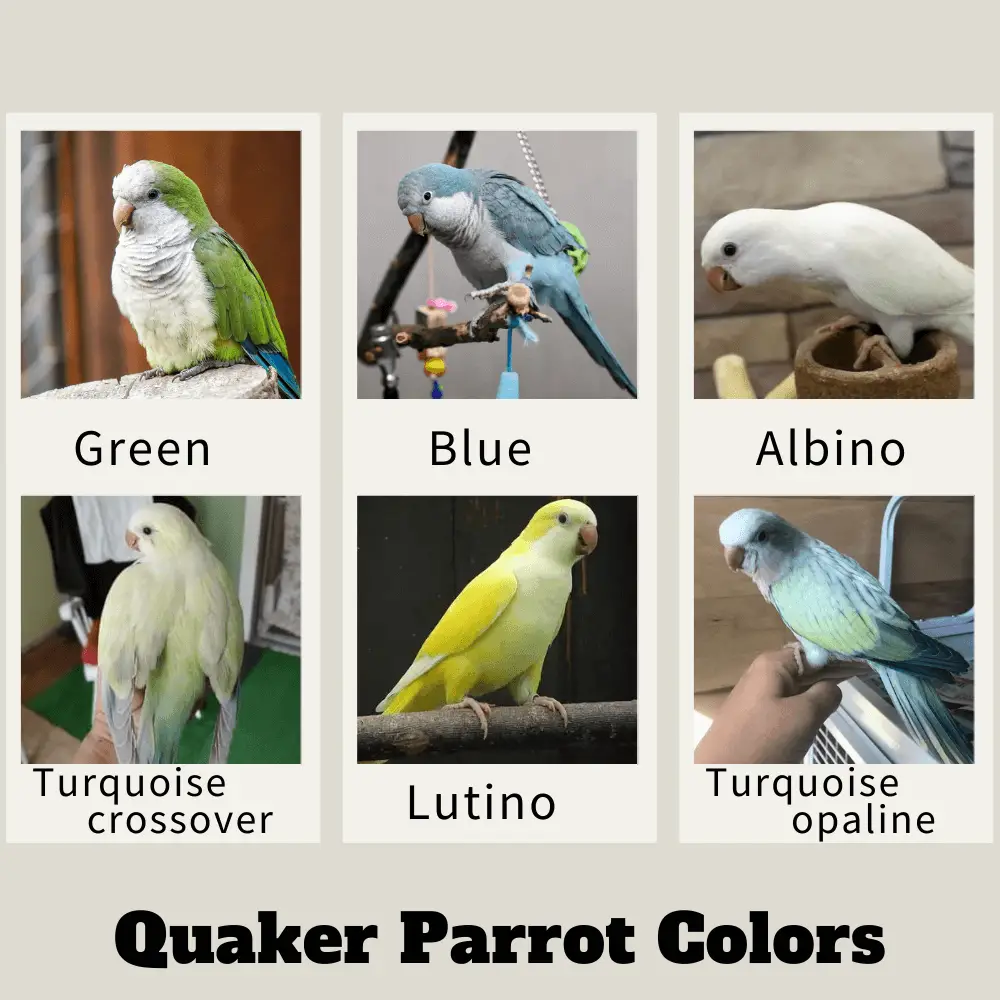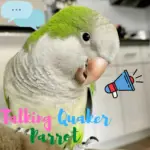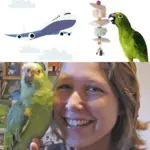
How to care for a Quaker parrot? The Quaker parrot – sometimes called a monk parrot, or Quaker parakeet, or monk – is an intelligent, playful, often talkative, and regularly mischievous bird species. Quakers can be a great addition to your family, but they require frequent and active care to thrive. If you are considering acquiring a Quaker parrot, think about your level of engagement; your ability to ensure the well-being of the bird; and your tolerance to noise, clutter, and missing trinkets. In the right environment, a Quaker can be an adorable companion for years (if not decades) to come.
Find out about cash. Quakers are neither the largest nor the most colorful of parrots, but they are among the most intelligent and (depending on the bird) the most talkative.
- They average about 11 to 13 inches in length and are usually grayish-white and green in color. They can live 30 years in captivity, so consider this a long-term addition to your household.
- Quakers are native to the temperate regions of South America but seem to thrive in just about any climate.
- Concerns about the ability of escaped Quakers to thrive and submerge native ecosystems partly explain why ownership of the species is banned or restricted in more than a dozen states, including California. Check the current policies of your home state before proceeding with any acquisition plan.
Know the trends of Quaker parrots. Terms like “intelligent,” “fearless,” “curious,” and “mischievous” appear frequently in Quaker descriptions, and for good reason. Living with a person is in many ways equivalent to living with a small child.
- They are usually quick learners and gifted imitators, so Quakers usually make very talkative avian companions. (Never assume that an individual parrot, regardless of its species, will be a talker, though.) Despite being talkative (and “garish”, for lack of a better term), however, they are usually not too noisy compared to other parrot species.
- Quakers build nests in the wild that are akin to apartment buildings, with multi-room “apartments” built next to those of other “tenants” in the vicinity. For this reason, they are naturally skilled borrowers (or thieves, depending on your point of view).
- Quakers will take anything from glasses to pens to scraps of paper and store them in their cages, as part of their instinct to collect materials for their elaborate nests.

Consider where you should acquire one. Quakers often cost between $50 and $200 to buy, making them manageable for most interested buyers. Not only the price but the personality of the bird you get can be determined by where you acquired it. Common areas include:
- A responsible breeder. It will cost more than alternatives, but it’s your best bet to have a hand-fed loving baby.
- A parrot rescue. Quakers may not be commonly available here, but if you’re lucky, you may be able to find one. You will not get a baby, but the cost will be less, and the parrot will be in a needy and loving home.
- A shelter. It’s unlikely you’ll find your Quaker here, but check anyway. You’ll probably have no idea about the history of your Quaker if you adopt from here, and the shelter route is only recommended for experienced bird owners.
- A pet store. Do your homework before you consider buying from here. Prices may be cheaper, but you may be getting an unhealthy bird that’s worth less than your money. Not to mention that many pet stores buy their parrots from unsavory sources that use inhumane methods to acquire and breed their birds.
- In the newspaper, online, etc. Some people can resettle their Quakers, and this is a good place to get one, but don’t forget to check that they are not relocating their parrot because of medical or behavioral problems.
Decide if you want to choose a baby or an adult bird. It may be tempting to think that an adult bird that has already been trained and socialized would be easier to maintain, especially for a novice, but this may not be the case. The best chance to train the bird, establish good habits and handle the bird is with a young.
- Quakers may develop a strong attachment to a particular individual, so an adult Quaker may have a hard time adjusting to a new home and a “parent.”
- In addition, unless you are sure of the bird’s history, you can acquire one with a history of behavioral problems, perhaps even because of neglect or abuse. This is a noble gesture to take in a rescue Quaker, but it can present too much of a challenge if you don’t have previous experience.
- As stated in the previous step, acquiring a hand-fed Quaker baby is probably the safest (if probably the most expensive) route, especially if you don’t have a lot of experience in caring for birds. There are no guarantees, of course, but a Quaker who has been cared for responsibly since birth is most likely to become a well-fitting and loving adult.
- If you choose a Quaker baby, set up your home with its cage, toys, etc. before it arrives, as you would with a baby crib and others. Be prepared to welcome him to his new home.
Part 1 Quiz
What differentiates a Quaker parrot from other parrots?
Buy the right cage. Quakers are a smaller breed of parrot, but due to their active nature, they do better with a spacious cage. An 18″ x 18″ x 18″ cage should probably be the minimum size for your bird, but also take into account safety and security features.
- Quaker parrots are known to be escape artists, so make sure that the bars in the cage are not too far apart, nor at the same time narrow enough for a curious Quaker to get their heads stuck between them. The 5/8 inch spacing between the bars is a good reference point.
- Similarly, to counter their curiosity and ability to escape, choose a door that opens (not a guillotine-style door that a Quaker could lift to become a trap). Quakers are known to understand how to unlock a door, so think about a lock as well.
Provide a diverse diet. A repetitive daily diet of bird food pellets not only lacks the diversity needed to provide proper nutrition, but it can also cause boredom (and therefore lack of food) in birds like Quakers.
- Incorporate the pellets into your diet, but also mix them with a variety of fruits and vegetables, and occasionally seeds and nuts.
- Avoid feeding the birds avocados, however, as this can be toxic to them; also skip the chocolate, caffeine, and alcohol.
Expect frequent damage and cleaning. Birds are messy – there is no way around it. In addition to feces, Quakers will spread leftover food, destroyed toys, and pieces of anything they can put their beaks on throughout the cage and on your floor.
- Quickly clean the cage every day, removing large pieces of garbage and replacing newsprint (you may want to subscribe to a daily newspaper if you are a bird owner).
- Every week, clean the cage more thoroughly, rub the bars, etc.
- You may want to place the cage on a floor surface that is easier to clean, such as tile or hardwood rather than carpet.
Find a good veterinarian. Take your Quaker for annual checkups (and more if warranted) by a veterinarian, preferably a bird veterinarian.
- The health of the beak, claws, and feathers should be areas of special interest to you and your veterinarian, as problems in these areas are often indicators of larger problems.
- Quakers may be more susceptible to fatty liver disease, so don’t let your bird become overweight. Limiting seeds and other high-fat foods may be necessary. Talk to your veterinarian if you are worried.
- Feather picking is another disorder that can be common in Quakers and can have physical or behavioral causes. A good bird veterinarian can also help you solve this problem.
Part 2 Quiz
How can you keep your Quaker healthy?
Want more quizzes?
Protect your bird. Due to their mischievous and sometimes reckless nature, you need to take steps to protect your Quaker from itself, not just people and other pets.
- The practice of cutting wings is controversial. Clipping makes leakage less likely and reduces the risk of injury when flying into objects. To see How to cut off the wings of a parrot or visit your veterinarian for more information. However, the ability of the bird to fly is reduced. This means he exercises less and is more likely to feel frustrated. In addition, many birds try to fly but crash to earth and damage their chest. These injuries can be quite serious and it is now thought that the cutting of the wings is outdated. Instead, proper training (such as clicker training) is preferable, to control the bird during the time out of the cage.
- Some Quakers are fearless (or perhaps stupid enough) to prey on cats or dogs, which can lead to serious injuries or worse, so be careful if you have other pets in the house. The only way to know how they will interact is to let this happen, but be prepared to keep Quakers separate from other pets if necessary.
- The same goes for other birds. Some Quakers thrive with an additional “partner in crime,” others not so much. Exposure at a young age is probably the best bet to succeed.
- Exposing your Quaker to other people from the beginning is also the best way to prevent it from becoming a “one-person bird” that only interacts well with you. It’s a two-way street, however, and you may need to teach people (especially kids) how to act around your parrot.
Play with your bird. Quakers need attention and usually enjoy playing, so find time each day to dedicate your bird’s mind and body.
- Teach your parrot to “climb” (jump on your finger when you tap it on the bird’s chest) from the beginning – this is a gateway to other commands, tricks, and games.
- Provide your Quaker with toys and mix them frequently to keep your parrot engaged. Quakers regularly destroy toys, so you may want to mix homemade toys, games, and challenges. For example, something as simple as putting a treat in a bundle of paper can provide your bird with mental stimulation (at least the first time).
- Talking is not a guarantee with a parrot, but Quakers generally like to talk and do it easily. Repeating sentences while reading is an easy way to teach new words or move on to targeted lessons of 10 to 15 minutes each.
- Keep in mind what Quakers hear from you (or television, etc.), as they are usually skilled and willing imitators.
- See also How to play with a large parrot for more game ideas.
Quaker Monk parakeet vs Dog
Keep the parrot actively engaged. Quakers want to “be part of the action,” so don’t isolate them in a cage nestled in a low-traffic spot. Like a small child, regular and active attention will make your Quaker happier and healthier.
- Locate your bird cage in the main living space, such as a living room. Place it in a corner (not far away) from the room, however, so that your Quaker can feel actively involved while having a piece of territory of its own.
- Also, give the birds plenty of daily time out of the cage. Do this not only for play but also during daily activities when possible. Make your Quaker a real part of the family.
Monk parrot Care
SOURCE:Quaker Parrot and Lovebirds




















